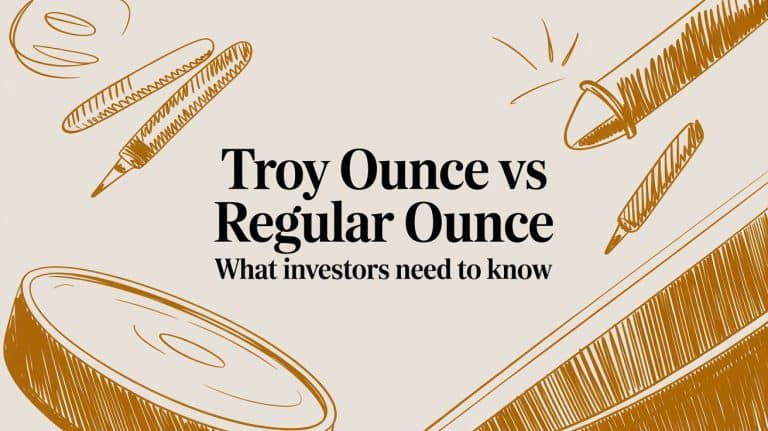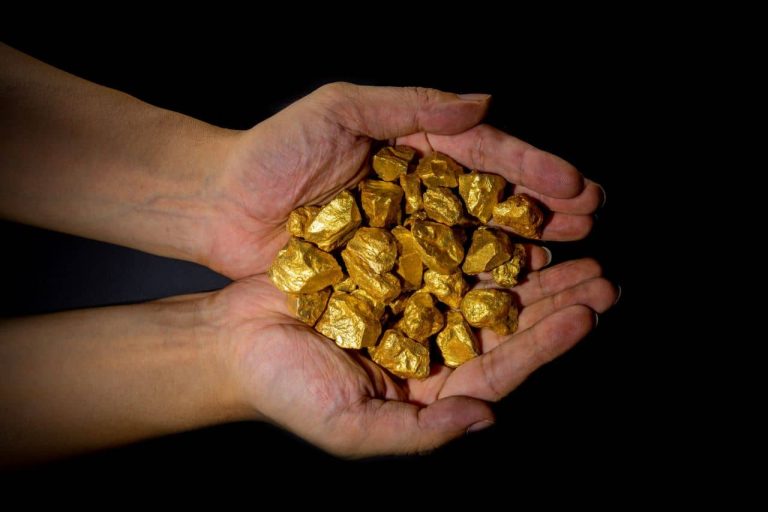How much is 1 gram 24k gold worth: A Simple Live Price Guide
Trying to pin down the exact value of 1 gram of 24k gold is like trying to catch a moving target. Its price is not a single, fixed number. Instead, it is tied directly to the live spot price of gold, a global benchmark that changes constantly throughout the day, much like a stock on the market.
While the exact figure is always in flux, it generally moves within a predictable daily range.
What 1 Gram of 24K Gold Is Worth Right Now
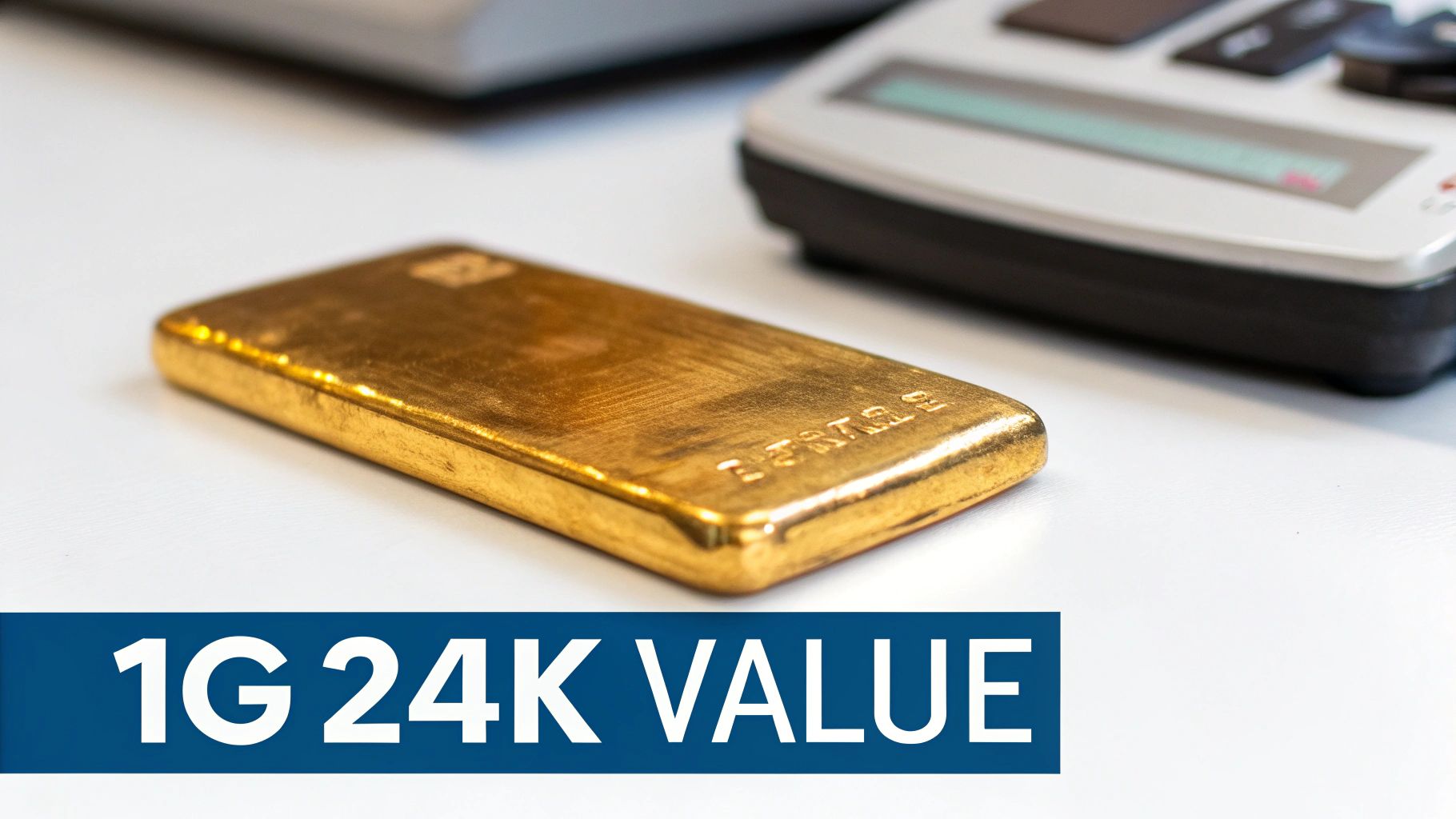
To get a handle on gold’s value, you have to start with the spot price. This is the price you see quoted on financial news channels, and it is always for one troy ounce of pure gold. A troy ounce, the standard unit for precious metals, is precisely 31.103 grams.
Because the market price is always on the move, the worth of your gram of gold moves right along with it. Everything from global economic news and currency fluctuations to investor demand can cause the price to shift minute by minute.
The Value at a Glance
So, how does the big troy ounce price translate to your single gram? The relationship is simple and direct. As the spot price for a troy ounce goes up or down, so does the value of each gram inside it. This connection is the foundation of all gold valuation.
To make this crystal clear, the table below shows the calculated price per gram at several different spot prices. It is a great way to see how even small market shifts directly impact the value of your gold.
24k Gold Price Per Gram at Different Spot Prices
This table illustrates how the value of 1 gram of 24k gold changes as the market spot price per troy ounce fluctuates, providing a clear reference for you.
| Gold Spot Price (per Troy Ounce) | Calculated Price per Gram (24k) |
|---|---|
| $2,200 | $70.73 |
| $2,300 | $73.95 |
| $2,400 | $77.16 |
| $4,000 | $128.6 |
As you can see, knowing the spot price is only the first step. The real magic is in the conversion.
The price you see on the news is for a troy ounce. To find the price of a single gram, you must divide that spot price by 31.103. This simple math gives you the baseline melt value for pure, 24k gold.
Understanding this calculation is the first and most critical step in figuring out what your gold is worth, long before you even think about selling it.
Understanding the Gold Spot Price
To figure out how much 1 gram of 24k gold is worth, you first have to get familiar with something called the spot price. Think of it as a massive, global auction where gold is constantly being bought and sold on major financial exchanges in places like New York, London, and Shanghai. The spot price is simply the current market price for a specific amount of pure gold at any given moment.
This price is not set by a committee in a boardroom. It is a living number, pushed and pulled by powerful global forces. The constant dance of supply and demand, the strength of currencies like the U.S. dollar, and the general mood of the economy all play a part in nudging the price up or down every single minute.
The Standard Unit of Measurement
When you hear financial news anchors talk about the price of gold, they are almost always quoting the price for one troy ounce. This is the official unit of measurement for precious metals, and it is a little bit heavier than the regular “avoirdupois” ounce you might use for cooking.
One troy ounce is equal to exactly 31.103 grams. This conversion is the absolute key to figuring out the value of a single gram from the troy ounce price you see quoted everywhere.
Getting this right is crucial. A common mistake is using the standard ounce conversion of 28.35 grams, which will throw off your calculations and give you the wrong value. If you want to dive deeper, you can explore the distinctions in our guide comparing the gold troy ounce vs a regular ounce.
What Drives the Daily Fluctuations
The value of gold has a fascinating, almost inverse relationship with the global economy. In major markets, the price of 1 gram of 24k gold often moves in the opposite direction of the US dollar and is heavily swayed by things like interest rates and geopolitical events.
For example, when central banks like the US Federal Reserve change interest rates, it directly impacts gold prices. Rising interest rates can make non yielding assets like gold less attractive compared to bonds, which pay interest. You can track these market movements and learn more about gold price trends on sites like JM Bullion.
The table below breaks down how different economic factors typically influence the spot price of gold, which in turn sets the value of your 1 gram of 24k gold.
| Economic Factor | Typical Impact on Gold Price | Why It Matters |
|---|---|---|
| Strong US Dollar | Tends to push gold price down | Gold is priced in USD, so a stronger dollar makes it more expensive for foreign buyers, which can reduce demand. |
| Rising Interest Rates | Tends to push gold price down | Higher rates make interest bearing assets more attractive, decreasing the appeal of holding non yielding gold. |
| Economic Uncertainty | Tends to push gold price up | During unstable times, investors often flock to gold as a “safe haven” asset, which drives up demand and price. |
| Inflation Concerns | Tends to push gold price up | Gold is widely seen as a store of value that can protect wealth when the purchasing power of money is falling. |
When you see your 1 gram of gold not just as a piece of metal but as a tiny share in this massive, interconnected market, you get a much clearer picture of where its value truly comes from.
How to Calculate the Value of Your Gold
Now that you have a handle on what the spot price is, let’s get into the simple math that tells you exactly what 1 gram of 24k gold is worth. You do not need to be a Wall Street trader to figure this out. It is actually a straightforward, two step process that pulls back the curtain on gold valuation.
First, you need the current spot price of gold, which is always quoted per troy ounce. Second, you just divide that number by 31.103, that is the exact number of grams in one troy ounce. That is it.
The number you get is the current market price for a single gram of pure, 24k gold. This figure is often called the melt value. Think of it as the raw, intrinsic worth of the metal itself, before anyone considers craftsmanship, brand names, or a buyer’s profit margin.
This quick bit of math puts you in the driver’s seat, giving you a solid baseline for your gold’s value before you even think about selling.
A Simple Formula and Real World Examples
The formula is incredibly easy to remember and is the foundation for all gold calculations.
(Current Gold Spot Price per Troy Ounce) / 31.103 = Price per 1 Gram of 24k Gold
Let’s walk through a few examples to see how it works in the real world. Since the spot price is always moving, we will use a few different price points to show you how the value of your gram shifts right along with the market.
This visual shows how that huge, global market price gets boiled down to the value of the small amount of gold you might be holding.
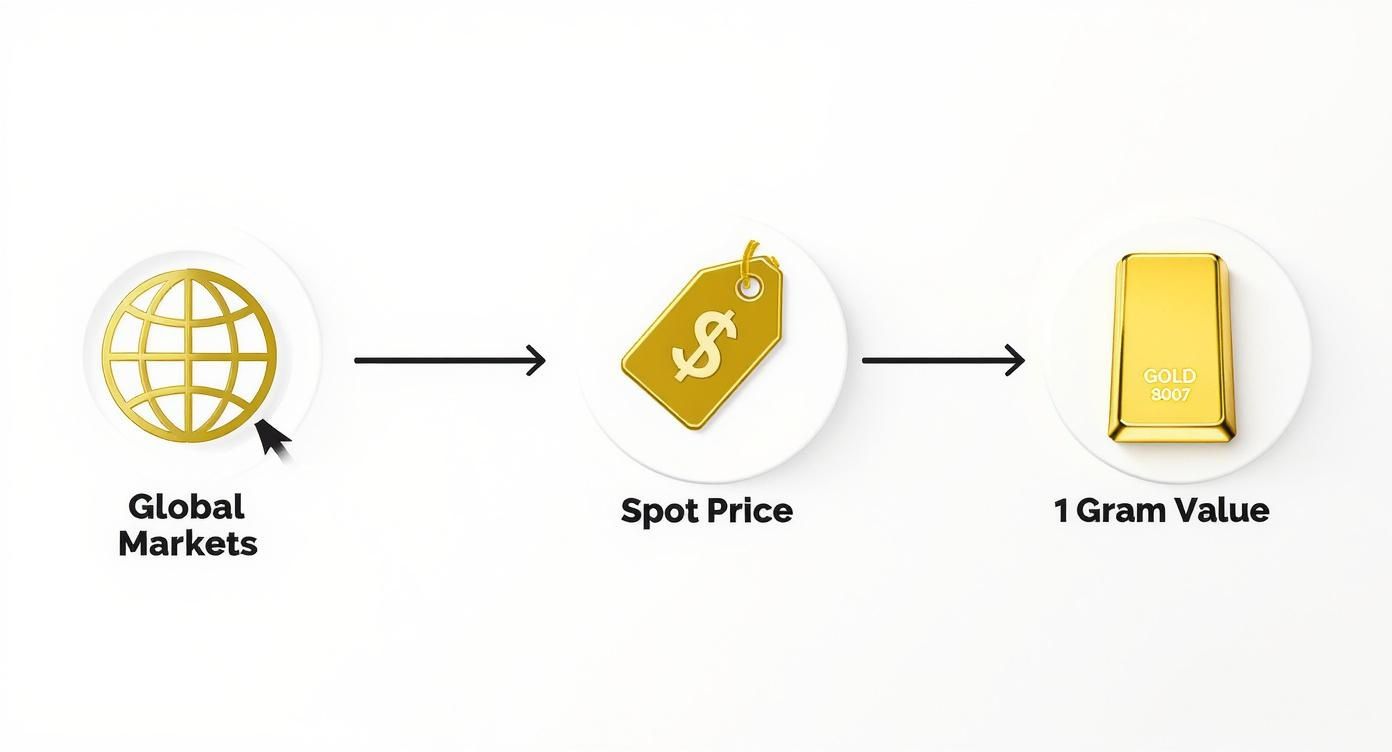
As you can see, the path from global markets to the value of your item is a direct line of simple conversion.
Putting the Calculation to the Test
To make this crystal clear, let’s plug some numbers into the formula. This hands on approach will give you the confidence to calculate your gold’s value on your own, no matter what the market is doing on any given day.
The table below breaks down how the per gram value is calculated from different troy ounce spot prices, hammering home the formula we just covered.
| If the Spot Price Is… | The Calculation Is… | The Value of 1 Gram of 24k Gold Is… |
|---|---|---|
| $2,350 per troy ounce | $2,350 / 31.103 | $75.56 per gram |
| $2,425 per troy ounce | $2,425 / 31.103 | $77.97 per gram |
| $2,500 per troy ounce | $2,500 / 31.103 | $80.38 per gram |
By mastering this simple division, you have gained a powerful tool. Whether you are just curious about a piece you own, a serious collector, or someone looking to sell, this fundamental knowledge ensures you are always starting from an informed position. It is the essential first step in any conversation about the true value of your gold.
Why You Are Offered Less Than the Spot Price
Here is a crucial piece of insight that clears up a lot of confusion when selling gold. The melt value you just calculated is the raw market price for pure gold, but it is not the amount of cash a buyer will actually hand you.
Think of it like selling a used car. There is the online sticker price, and then there is the final offer you get at the dealership after they have inspected it and factored in their own costs. The same principle applies to gold.
Gold buyers, from local jewelers to large scale refiners, are running a business. To stay in business, they have to buy your gold at a price that allows them to cover their expenses and still make a profit.
Understanding the Buyer’s Costs
When a buyer makes you an offer, they are not just thinking about the gold’s value. They are subtracting several real world business expenses from that total. Their final offer needs to cover these costs while leaving a margin for them to operate.
These costs almost always include things like refining fees, operational overhead, and market risk. For example, even an item marked 24k often needs to be melted down and professionally re assayed to guarantee its purity. That refining process is not free. Their overhead includes daily business expenses like rent, employee salaries, and insurance. Finally, they take on the risk that the spot price could drop between when they buy your gold and when they can sell it.
Because of these factors, an offer will always be below the full spot price. This is a standard and necessary part of the industry, not a sign that you are being ripped off. It is just business.
From Melt Value to Cash Offer
So, how much less than the melt value should you expect? It can vary quite a bit, but most reputable dealers will offer between 70% and 95% of the spot melt value.
On the lower end, you might find pawn shops offering closer to 40%, while specialized precious metal refiners who deal in large volumes can often give you the most competitive rates.
Let’s run through a quick example to see how this plays out in a table format.
| Metric | Example Value |
|---|---|
| Spot Price of Gold | $2,400 per troy ounce |
| Value of 1 Gram of 24k Gold | $77.16 ($2,400 / 31.103) |
| A Buyer’s Offer (at 85% of spot) | $65.59 ($77.16 x 0.85) |
This gap between the melt value and the final offer is where the buyer makes their money. Understanding this helps you set realistic expectations and spot a fair deal when you see one. Knowing the difference between the raw value and a cash offer is a critical part of understanding the true scrap gold price.
By knowing your gold’s melt value beforehand, you can enter any negotiation from a position of strength, confidently recognizing a fair offer when you see one.
Why Gold Purity and Karats Matter
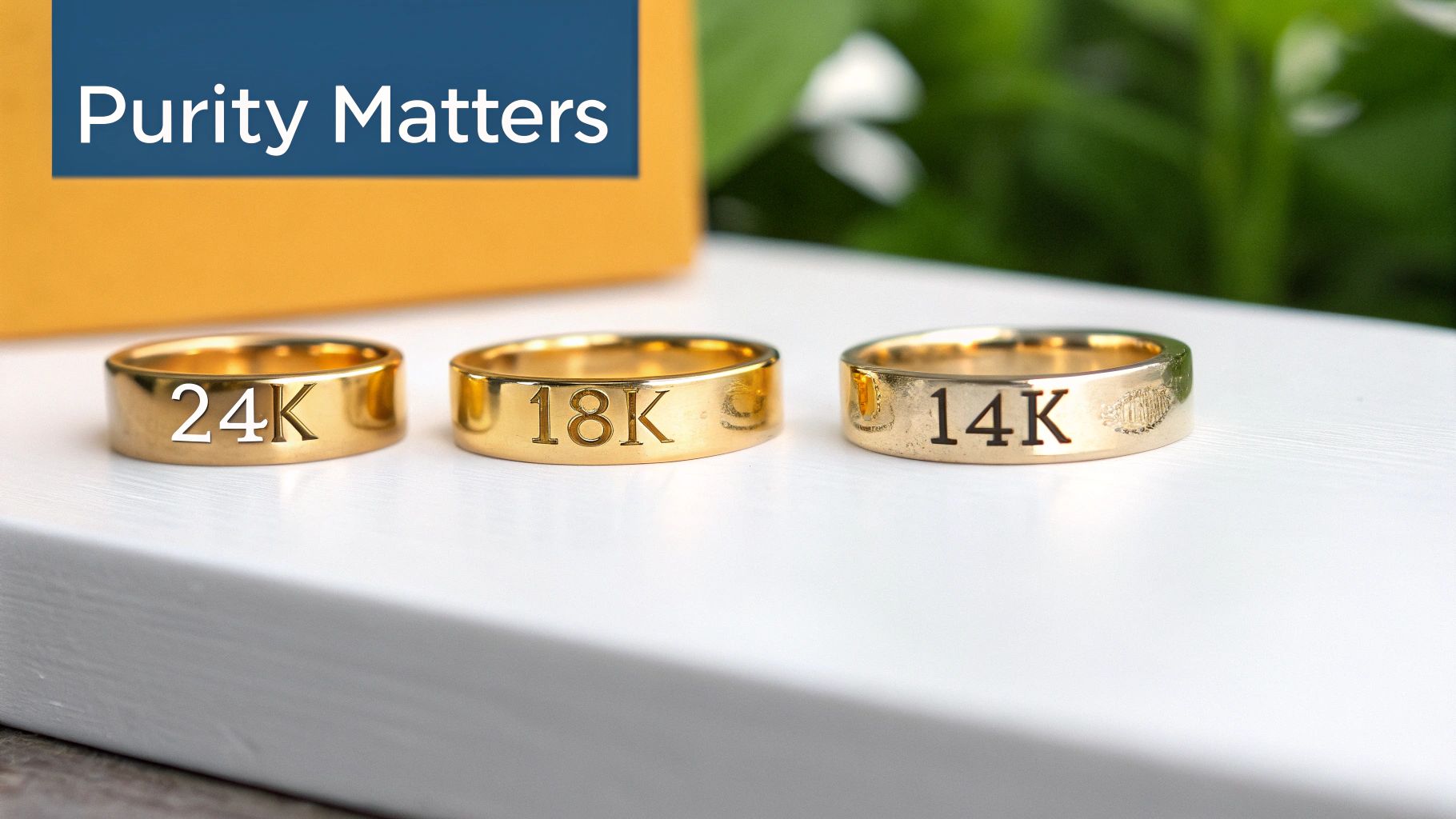
That tiny “24k” stamp you see on a gold bar is more than just a label. It is a direct measure of its purity, which is the single biggest factor in determining its value.
Think of the karat system as a simple fraction out of 24. 24k gold sits at the top, meaning it is made of 24 out of 24 parts pure gold, or 99.9% pure. This is why it is the standard for investment grade bullion like coins and bars. But that same purity makes the metal incredibly soft and easy to damage, which is not ideal for a piece of jewelry you wear every day.
From Pure Gold to Durable Alloys
To make gold strong enough for everyday items like rings, bracelets, and necklaces, jewelers get creative. They mix pure gold with stronger metals like copper, silver, or zinc to create what is known as an alloy. This process adds durability but lowers the gold purity, resulting in a lower karat number.
For instance, 18k gold is made of 18 parts gold and 6 parts other metals, making it 75% pure. Go down to 14k gold, and you have 14 parts gold mixed with 10 parts other metals, bringing its purity to 58.3%.
This distinction is crucial when you are calculating value. A 10 gram chain marked “14k” does not have 10 grams of pure gold. It actually contains just 5.83 grams of it, and its value is based only on that amount. This is why knowing the karat is just as important as knowing the weight.
The lower the karat, the less pure gold an item has per gram. This directly impacts its melt value. Two items can weigh exactly the same but have wildly different values if their karats are different.
To see this in action, here is a quick breakdown in a table of the most common karat types and their corresponding gold content.
| Karat Value | Parts of Gold (out of 24) | Purity Percentage |
|---|---|---|
| 24k | 24 | 99.9% |
| 18k | 18 | 75.0% |
| 14k | 14 | 58.3% |
| 10k | 10 | 41.7% |
Getting a handle on this concept is the first real step to accurately valuing any gold you own. If you are curious about how to verify the purity of your items at home, our complete guide on how to test gold purity breaks down several easy methods.
The Enduring Value of Gold Over Time
Beyond its day to day price swings, gold tells a much deeper story about long term value and financial security. While knowing how much 1 gram of 24k gold is worth today is certainly useful, taking a step back to look at its historical performance shows exactly why it has been a trusted asset for thousands of years. Gold has an almost unique ability to hold its value against the slow burn of inflation and the sudden shock of economic turbulence.
This resilience is never more obvious than during times of global crisis. When traditional financial systems start to creak under pressure, investors instinctively flock to gold as a safe haven. It is a real, tangible asset that is not tied to the policies of any single government or the performance of a specific company. This independence makes it an incredibly reliable store of wealth when confidence in everything else begins to falter.
A Historical Safe Haven
A perfect example of this was the 2008 global financial crisis. As stock markets went into a freefall and deep uncertainty swept across the globe, investors piled into the perceived safety of gold. This massive surge in demand sent its price skyrocketing, cementing its reputation as a dependable anchor in a financial storm.
This is not just a one off event. This historical performance gives you a much richer appreciation for why gold is so much more than just another commodity. Over the past few decades, it has consistently proven its ability to preserve wealth through one economic cycle after another. This track record is why generations have trusted it not just for its beauty, but for its enduring financial stability.
For example, you can look at gold price trends over 20 years to see this resilience in action. Data shows that the price of gold has seen substantial long term growth, providing a hedge against economic downturns and currency devaluation over time.
This journey through modern history makes it clear that gold’s value is not just about daily price charts. It is about its proven role as a timeless asset that provides stability right when you need it most. The table below really drives this point home, showing how gold has performed during key periods of economic stress and proving its consistent appeal as a safe haven investment.
| Historical Event | Economic Climate | Impact on Gold Price |
|---|---|---|
| Dot Com Bubble (2000) | Stock market volatility and crash | Increased demand, steady price appreciation |
| 2008 Financial Crisis | Global recession and banking failures | Major price surge to record highs |
| COVID 19 Pandemic (2020) | Widespread economic shutdown | Sharp increase as investors sought safety |
Frequently Asked Questions About Gold Value
Even with a good handle on how gold’s value is determined, a few practical questions always seem to pop up. Think of this section as a quick reference to clear up those common sticking points and make sure you have every detail you need.
Why Does the Price of Gold Change So Often?
The price of gold is constantly on the move because it is traded on a dynamic global market that never sleeps. Its value is tied directly to big picture economic forces like supply and demand, the strength of the U.S. dollar, and major world events.
For example, during times of economic uncertainty, investors often flock to gold as a safe haven asset, which naturally drives the price up. On the flip side, when the economy is booming and investors feel confident putting their money into stocks, the price of gold might dip. This constant push and pull is what keeps the price in flux.
Is 24k Gold Considered Pure Gold?
Yes, for all practical purposes in the consumer and investment world, 24k gold is considered pure gold. It is defined as being 99.9% pure, which is the highest level of purity you will typically find in commercially available gold bars, coins, and high end jewelry.
That last 0.1% is made up of trace elements that are incredibly difficult and expensive to remove during the refining process. Because of this, the 99.9% standard is universally accepted as pure.
How Can I Get the Best Price When Selling My Gold?
Getting the best possible price for your gold comes down to a few smart moves. First, always calculate its current melt value yourself using the live spot price. This gives you a solid, non negotiable baseline. From there, your next step should be getting offers from several different reputable buyers, like established local jewelers or specialized precious metal dealers.
Here is a general idea in a table of what to expect from different types of buyers.
| Buyer Type | Typical Payout Range (% of Spot) | Best For |
|---|---|---|
| Pawn Shops | 40% to 60% | Quick cash, but often the lowest offer. |
| Local Jewelers | 70% to 85% | Convenient and generally fair offers. |
| Online Refiners | 80% to 95% | Often the highest payout, especially for larger amounts. |
Do not forget that any offer you receive will be below the full spot price. This is perfectly normal, as it allows the buyer to cover their operational costs and make a profit. By comparing a few offers, you can make sure you are getting a fair and competitive price for your items.
For instant, accurate calculations based on live market data, use our free gold calculator tool. Our real time calculator empowers you to find the true melt value of your gold in seconds, so you can negotiate with confidence.






